Physics 53 Polarization (2 of 5) Two Polarizers
TLDRThis educational script explains the concept of light intensity through polarizers. It starts by stating that light loses half its intensity after passing through the first polarizer. The script then introduces a formula to calculate the intensity after a second polarizer, which depends on the angle between the two. Using 30° as an example, it shows that the light's intensity is further reduced to 37.5% of the original. Finally, it illustrates the total blockage of light when the second polarizer is perpendicular to the first, demonstrating the principle behind polarization in sunglasses.
Takeaways
- 🔆 The intensity of light passing through the first polarizer is reduced to half of its original intensity.
- 📏 The intensity after the second polarizer is calculated using the formula \( I_2 = I_1 \times \cos^2(\Theta_1) \), where \( \Theta_1 \) is the angle between the polarizers.
- 📐 When the second polarizer is at a 30° angle to the first, the intensity through the second is \( 0.75 \times I_1 \).
- 🔄 The intensity after the second polarizer can be further expressed as \( I_2 = 0.375 \times I_0 \), where \( I_0 \) is the original intensity.
- 🕶️ If the second polarizer is perpendicular (90°) to the first, no light passes through, as the cosine of 90° is zero.
- 👓 Demonstrating with polarized sunglasses, holding one pair perpendicular to another shows no light transmission.
- 🌟 The principle of polarization is effectively used in sunglasses to reduce glare and improve visual comfort.
- 📉 The intensity loss through polarizers is cumulative and depends on the angle between them.
- 📚 Understanding the angle between polarizers is crucial for predicting the transmitted light intensity.
- 📈 The script provides a step-by-step example to illustrate the calculation of light intensity through polarizers.
- 🔬 The concept is applicable in various scenarios, including optics and everyday items like sunglasses.
Q & A
What happens to the intensity of light when it passes through the first polarizer?
-The intensity of light is reduced to half of its original value when it passes through the first polarizer.
How do you calculate the intensity of light after it passes through a second polarizer that is at an angle to the first one?
-The intensity of light after passing through the second polarizer is calculated using the equation I2 = I1 * cos²(θ), where θ is the angle between the first and second polarizers.
What is the intensity of light after passing through two polarizers if the second polarizer is at a 30° angle relative to the first?
-If the second polarizer is at a 30° angle relative to the first, the intensity of light passing through the second polarizer is 37.5% of the original intensity.
Why is the intensity reduced to 37.5% when the angle between the polarizers is 30°?
-The reduction to 37.5% occurs because the light's intensity after passing through the second polarizer is determined by the cosine squared of the angle between the polarizers, which for 30° is cos²(30°) = 0.75.
What happens to the intensity of light if the second polarizer is perpendicular (90°) to the first one?
-If the second polarizer is perpendicular (90°) to the first one, no light passes through, resulting in zero intensity.
Why does no light pass through when the polarizers are at 90° to each other?
-No light passes through because the cosine of 90° is zero, and since the intensity depends on cos²(θ), the intensity becomes zero when the polarizers are perpendicular.
What practical example is given to demonstrate the effect of perpendicular polarizers?
-A practical example given is using two pairs of polarized sunglasses. When one is held upright and the other perpendicular, no light passes through, demonstrating the effect of perpendicular polarizers.
How is the concept of polarization useful in real-life applications?
-Polarization is useful in applications like polarized sunglasses, which reduce glare by blocking certain orientations of light waves.
What additional scenarios are mentioned for future examples in the script?
-The script mentions future examples where polarizers will be placed at various angles relative to each other, and more than two polarizers will be used to explore the effects.
How does the script suggest verifying the effect of perpendicular polarizers at home?
-The script suggests using two pairs of polarized sunglasses, positioning one pair upright and the other perpendicular, to observe that no light passes through.
Outlines
🔬 Calculating Light Intensity Through Polarizers
This paragraph explains the process of calculating the intensity of light that passes through two polarizers oriented at different angles. It begins by stating that the first polarizer reduces the light's intensity by half. The second polarizer's effect is then calculated using the formula I₂ = I₁ * cos²(θ), where θ is the angle between the polarizers. The example given uses a 30° angle, resulting in a further reduction to 37.5% of the original intensity. The paragraph also discusses the scenario where the second polarizer is perpendicular (90°) to the first, which would block all light. The explanation includes practical examples, such as using polarized sunglasses, to illustrate the concept.
Mindmap
Keywords
💡Intensity of Light
💡Polarizers
💡Angle
💡Cosine Square
💡Original Intensity
💡I sub 1 and I sub 2
💡Percentage
💡Perpendicular
💡Polarized Sunglasses
💡Light Waves
Highlights
The process of calculating light intensity through polarizers is explained step by step.
Intensity after the first polarizer (I1) is half of the original intensity (I0).
The equation for calculating intensity after the second polarizer (I2) is I2 = I1 * cos²(θ), where θ is the angle between the polarizers.
When the second polarizer is at a 30° angle to the first, the intensity loss is calculated using cos²(30°).
Cosine of 30° squared results in 0.75, indicating the intensity after the second polarizer is 75% of the intensity after the first.
I2 is expressed as 0.375 times I0, showing a 62.5% intensity reduction from the original.
If the second polarizer is perpendicular (90°) to the first, no light passes through, as cos(90°) is zero.
Demonstrates the practical application of polarizers with an example of sunglasses blocking light when crossed.
Explains the principle behind polarization and its effectiveness in blocking light at perpendicular angles.
The transcript includes further examples of polarizers at various angles to explore light transmission.
The importance of angle θ in determining the intensity of light passing through multiple polarizers is emphasized.
The mathematical relationship between polarizer angles and light intensity is clearly outlined.
The concept of light losing intensity with each polarizer is introduced and explained.
The transcript provides a clear understanding of how polarizers work in pairs to control light intensity.
The impact of polarizer orientation on light transmission is thoroughly discussed.
A real-world analogy of polarized sunglasses is used to illustrate the concept of light blocking.
The transcript concludes with a mention of additional examples to further understand polarizer interactions.
Transcripts
Browse More Related Video
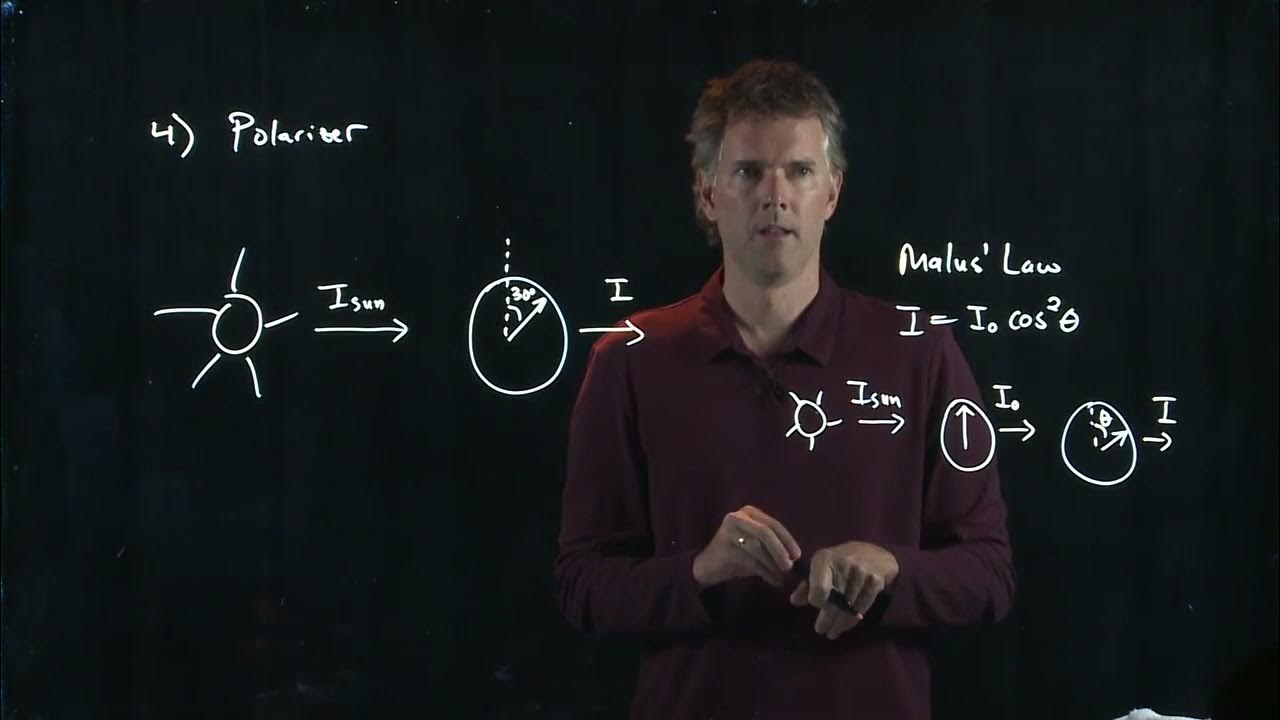
The Polarizer | Physics with Professor Matt Anderson | M28-17
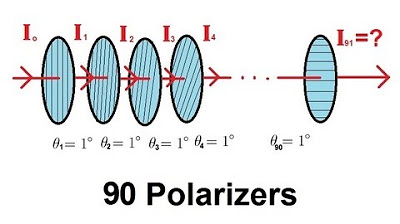
Physics 53 Polarization (4 of 5) Ninety Polarizers

Physics 53 Polarization (3 of 5) Three Polarizers
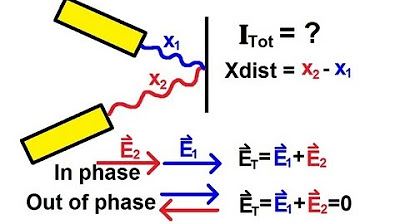
Physics 60 Interference of Light (1 of 8) Path and Phase Difference: Introduction
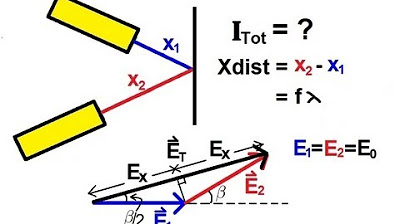
Physics 60 Interference of Light (3 of 8) Path and Phase Difference: General Case
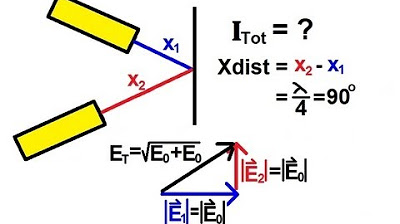
Physics 60 Interference of Light (2 of 8) Path and Phase Difference
5.0 / 5 (0 votes)
Thanks for rating: